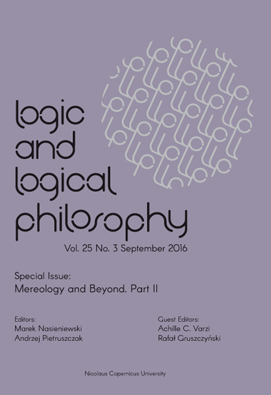The mereology of structural universals
DOI:
https://doi.org/10.12775/LLP.2015.012Keywords
mereology, conjunction, existential binding, David Lewis, reflexive binding, structural universals, unique fusionAbstract
This paper explores the mereology of structural universals, using the structural richness of a non-classical mereology without unique fusions. The paper focuses on a problem posed by David Lewis, who using the example of methane, and assuming classical mereology, argues against any purely mereological theory of structural universals. The problem is that being a methane molecule would have to contain being a hydrogen atom four times over, but mereology does not have the concept of the same part occurring several times. This paper takes up the challenge by providing mereological analysis of three operations sufficient for a theory of structural universals: (1) Reflexive binding, i.e. identifying two of the places of a universal; (2) Existential binding, i.e. the language-independent correlate of an existential quantification; and (3) Conjunction.References
Armstrong, D., Universals and Scientific Realism, Vol. II. A Theory of Universals, Cambridge: Cambridge University Press, 1978.
Bigelow, J., “Towards structural universals”, Australasian Journal of Philosophy, 64 (1986): 94–96. DOI:10.1080/00048408612342291
Caplan, B., Ch. Tillman, and P. Reeder, “Parts of singletons”, Journal of Philosophy, 107 (2010): 501–533.
Cotnoir, A.J., “Anti-symmetry and non-extensional mereology”, The Philosophical Quarterly, 60 (2010): 396–405. DOI:10.1111/j.1467-9213.2009.649.x
Cotnoir, A.J., and A. Bacon, “Non-wellfounded mereology”, Review of Symbolic Logic, 5 (2012): 187–204. DOI:10.1017/S1755020311000293
Forrest, P., The Necessary Structure of the All-pervading Aether: Discrete or Continuous? Simple or Symmetric?, Ontos, 2012. DOI:10.1515/9783110325928
Forrest, P., “Exemplification and parthood”, Axiomathes, 23 (2013): 323–341. DOI:10.1007/s10516-013-9215-6
Franklin, J., An Aristotelian Realist Philosophy of Mathematics: Mathematics as the Science of Quantity and Structure, Palgrave MacMillan, 2014. DOI:10.1057/9781137400734
Lewis, D., “Against structural universals”, Australasian Journal of Philosophy, 64 (1986): 25–46. DOI:10.1080/00048408612342211
Lewis, D., Parts of Classes, Blackwell, 1991.
Obojska, L., “Some remarks on supplementation principles in the absence of antisymmetry”, Review of Symbolic Logic, 6 (2013): 343–347. DOI:10.1017/S1755020312000330
Sober, E., “Why logically equivalent predicates may pick out different properties”, American Philosophical Quarterly, 19 (1982): 183–189.
Thompson, J.J., “The statue and the clay”, Nous, 32 (1998): 149–173. DOI:10.1111/0029-4624.00094
Tillman, Ch., and G. Fowler, “Propositions and parthood: The universe and antisymmetry”, Australasian Journal of Philosophy, 90 (2012): 525–539. DOI:10.1080/00048402.2011.611812
Varzi, A., “The extensionality of parthood and composition”, The Philosophical Quarterly, 58 (2008): 108–133. DOI:10.1111/j.1467-9213.2007.542.x
Downloads
Published
How to Cite
Issue
Section
Stats
Number of views and downloads: 2470
Number of citations: 7







